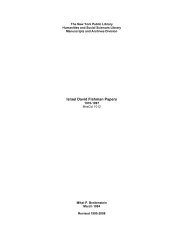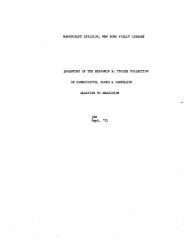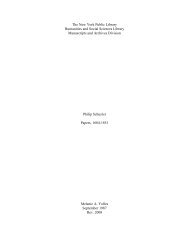pdf available - Multiple Choices
pdf available - Multiple Choices
pdf available - Multiple Choices
Create successful ePaper yourself
Turn your PDF publications into a flip-book with our unique Google optimized e-Paper software.
256 LUBOML<br />
Kopelzon went to the commandant, who took the<br />
valuables and said everybody would be set free in<br />
a couple of days. But only a few were released.<br />
Most of the others were taken to the Boris Woods<br />
and shot.<br />
While this was going on, the authorities<br />
levied several heavy "contributions" from the<br />
people. The first amounted to 100,00 rubles, the<br />
second to 200,000 rubles; the third to 50 gold<br />
pieces and fabric for suits. The sums were raised<br />
with great difficulty and paid to the Germans. The<br />
Jews still thought that by paying, their lot would<br />
be improved: perhaps America would help; perhaps<br />
the world. . . .<br />
The Yellow Patch and Hunger<br />
By then about 900 Jews had been murdered in our<br />
shtetl. On Yom Kippur of 1941, the Ukrainians<br />
petitioned the commandant to forbid the Jews to<br />
live on the same streets with them. At the same<br />
time an order came through making all Jews wear<br />
a yellow patch. A fine of 10,000 rubles or shooting<br />
was the punishment for not wearing the patch.<br />
The command to leave the gentile streets and<br />
villages came out in November, 1941. At the<br />
same time a plan was issued telling the Judenrat<br />
which streets were to be evacuated by the Jews<br />
and indicating which streets were to be included<br />
in the Jewish ghetto.<br />
The next day the Judenrat informed the Jews<br />
of the new evil decree: Jews could live only on<br />
Kusnishtcher Street, on parts of Koshtshelna and<br />
Chelm Streets, in Novy Svyat with its alleys, and<br />
on Railroad Street, stretching from the house of<br />
Chayim Sokolovsky to the former Starostva, near<br />
Tseylingold's Hotel.<br />
Living quarters in the shtetl became overcrowded.<br />
Two or three families were forced to<br />
live in one room. Then winter came; and as if to<br />
spite the Jews it was a very harsh winter. Some<br />
gentiles would sneak into Jewish homes early in<br />
the morning to sell them some potatoes, wood for<br />
heating, flour and other food. There was not<br />
enough to feed the whole town. First of all, the<br />
peasants did not have enough produce themselves;<br />
and secondly they bartered for clothing, salt, or<br />
kerosene, which not every Jew had, since the<br />
greater part of the town had been burned down at<br />
the time of the first battles.<br />
The situation became desperate. Some Jews<br />
even died of hunger or cold.<br />
At the end of 1941, the Germans confiscated<br />
all the food reserves anyone had and, instead,<br />
issued food-ration cards, allowing a half-pound<br />
of bread for adults and 4 ounces for children.<br />
Passover was approaching. The Judenrat went<br />
to the wealthier Jews and collected some money<br />
from them. They gave this money to the commissar,<br />
who permitted them to bake matzos and even<br />
to sell some flour for this purpose.<br />
The matzo was baked in secret, so as not to<br />
inflame the Ukrainian police, who would confiscate<br />
the flour since it was above the bread ration<br />
allowed by the authorities. Despite difficulties,<br />
the matzos were baked. The mashgichim [overseers<br />
to check that the matzo was kosher for<br />
Passover] were Leybl Dayen and Shmuel Avrom<br />
Eltster. And during the excitement of matzo<br />
baking, each and every one wished each other<br />
"L'shana hubo b'Yirusholayim" (may we be in<br />
Jerusalem next year).<br />
Passover passed without incident. Jews came<br />
together in various homes to pray and said memorial<br />
prayers for the holy martyrs who had<br />
lost their lives in 1941.<br />
The Ghetto<br />
On December 6, 1941 the ghetto was finally<br />
organized. A summary death-penalty threatened<br />
anyone crossing the borders of the ghetto. A<br />
Jewish policeman would take the Jewish worker<br />
to his place of work and bring him back at night.<br />
There were two ghettos: one for artisans, set<br />
aside along Koleyova Street, from Chayim<br />
Sokolovsky's house up to Tseylingold's Hotel;<br />
encompassing four houses on Chelm Street, between<br />
Nute Fuks' house, up to the avenue<br />
crossway; and a piece of Ludmir Street, up to the<br />
post office and the house of Veytsfrucht. The<br />
artisans living here had red work-cards. The<br />
second part of the ghetto was situated along<br />
Kusnishtcher, Ribne, and Koshtshelna Streets.<br />
Day by day the situation was worsening. The<br />
small reserves of food were used up bit by bit.<br />
The peasants were forbidden to enter the ghetto to<br />
sell any produce to Jews.<br />
At that time, I and some other Jews were<br />
working on the railroad. We had our cards with







